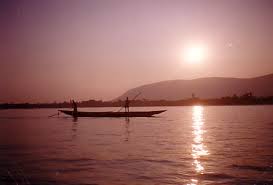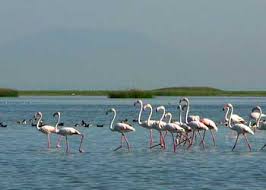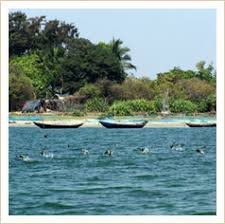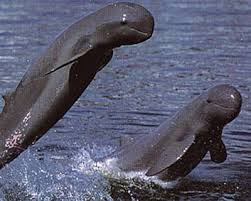 Chilka Lake (Chilika Lake) is a brackish water lagoon, spread over the Puri, Khurda and Ganjam districts of Orissa state on the east coast of India, at the mouth of the Daya River, flowing into the Bay of Bengal. It is the largest coastal lagoon in India and the second largest lagoon in the World.It is the largest wintering ground for migratory waterfowl found anywhere on the Indian sub-continent. It is one of the hotspot of biodiversity in the country, and some rare, vulnerable and endangered species listed in the IUCN Red List of threatened Animals inhabit in the lagoon for atleast part of their life cycle.Chilka Lake is designated as a wetland of international importance under the Ramsar Convention.
Chilka Lake (Chilika Lake) is a brackish water lagoon, spread over the Puri, Khurda and Ganjam districts of Orissa state on the east coast of India, at the mouth of the Daya River, flowing into the Bay of Bengal. It is the largest coastal lagoon in India and the second largest lagoon in the World.It is the largest wintering ground for migratory waterfowl found anywhere on the Indian sub-continent. It is one of the hotspot of biodiversity in the country, and some rare, vulnerable and endangered species listed in the IUCN Red List of threatened Animals inhabit in the lagoon for atleast part of their life cycle.Chilka Lake is designated as a wetland of international importance under the Ramsar Convention.
 High tides near this inlet mouth drive in salt water through the channel during the dry months, from December to June. With the onset of the rains, the 52 river and rivulets falling into the Chilika are in spate, causing fresh water currents which gradually push the sea water out. Due to littoral drift prevailing along the east coast the inlet mouth constantly changes position.The pear-shaped lagoon is about 64.5 km long and its width varies from 18 km to 5 km (Das and Samal 1988). The lagoon is connected to sea by a 32 km long, channel with several shoal restricting the flow and head loss . About 1.5 km wide, the channel runs parallel to the Bay of Bengal and is separated from it by a narrow spit whose width very between 100m to several kilometers. The channel opens to the sea near village Motto which is extremely narrow. The highly productive chilika lagoon eco-system with its rich fishery resources sustains the livelihood for many fisher men who live in and near the Lagoon. The water spread area of the Lagoon ranges between 1165 to 906 sq.km during the monsoon and summer respectively.Chilika undergoes a cyclical variation in salinity throughout the year, with different patterns seen in separate sectors.Thus a salinity gradient is maintained.
High tides near this inlet mouth drive in salt water through the channel during the dry months, from December to June. With the onset of the rains, the 52 river and rivulets falling into the Chilika are in spate, causing fresh water currents which gradually push the sea water out. Due to littoral drift prevailing along the east coast the inlet mouth constantly changes position.The pear-shaped lagoon is about 64.5 km long and its width varies from 18 km to 5 km (Das and Samal 1988). The lagoon is connected to sea by a 32 km long, channel with several shoal restricting the flow and head loss . About 1.5 km wide, the channel runs parallel to the Bay of Bengal and is separated from it by a narrow spit whose width very between 100m to several kilometers. The channel opens to the sea near village Motto which is extremely narrow. The highly productive chilika lagoon eco-system with its rich fishery resources sustains the livelihood for many fisher men who live in and near the Lagoon. The water spread area of the Lagoon ranges between 1165 to 906 sq.km during the monsoon and summer respectively.Chilika undergoes a cyclical variation in salinity throughout the year, with different patterns seen in separate sectors.Thus a salinity gradient is maintained.

 White bellied sea eagles, greylag geese, purple moorhen, jacana, herons and flamingos, Egrets, Gray and Purple Herons, Indian Roller, Storks and White Ibis, Spoonbills, Brahminy Ducks, Shovellers and Pintails, and more.Migratory water fowl arrive here from as far as the Caspian Sea, Baikal Lake and remote parts of Russia, Mongolia, Lakah, Siberia, Iran, Iraq, Afghanistan and from the Himalayas. A census conducted in the winter of 1997-98 recorded about 2 million birds in the lake. Other than birds, blackbucks, hyenas, golden jackals, spotted deer are also found in the regions nearby.
White bellied sea eagles, greylag geese, purple moorhen, jacana, herons and flamingos, Egrets, Gray and Purple Herons, Indian Roller, Storks and White Ibis, Spoonbills, Brahminy Ducks, Shovellers and Pintails, and more.Migratory water fowl arrive here from as far as the Caspian Sea, Baikal Lake and remote parts of Russia, Mongolia, Lakah, Siberia, Iran, Iraq, Afghanistan and from the Himalayas. A census conducted in the winter of 1997-98 recorded about 2 million birds in the lake. Other than birds, blackbucks, hyenas, golden jackals, spotted deer are also found in the regions nearby.
 Nalbana Island is the core area of the Ramsar designated wetlands of Chilika Lake. Nalbana means a weed covered island In the Oriya language. It is a major island in the center of the lake and has an area of 15.53 km2 (6.0 sq mi). The island gets completely submerged during the monsoon season. As the monsoon recedes in the winter, lake levels decrease and the island is gradually exposed, birds flock to the island in large numbers to feed on its extensive mudflats. The Irrawaddy Dolphin (Orcaella brevirostris) is the flagship species of Chilika lake. Chilka is home to the only known population of Irrawaddy dolphins in India and one of only two lagoons in the world that are home to this species. It is classified as Critically Endangered, in five of the six other places it is known to live. A small population of Bottlenose dolphins, also migrate into the lagoon from the sea. Somolo and Dumkudi islands are located in the Central and Southern sectors of the lake, in the backdrop of scenic Khalikote hill range, are inundated remnants of the Eastern Ghats with rich flora and fauna and also known for sighting of Irrawaddy Dolphins.
Nalbana Island is the core area of the Ramsar designated wetlands of Chilika Lake. Nalbana means a weed covered island In the Oriya language. It is a major island in the center of the lake and has an area of 15.53 km2 (6.0 sq mi). The island gets completely submerged during the monsoon season. As the monsoon recedes in the winter, lake levels decrease and the island is gradually exposed, birds flock to the island in large numbers to feed on its extensive mudflats. The Irrawaddy Dolphin (Orcaella brevirostris) is the flagship species of Chilika lake. Chilka is home to the only known population of Irrawaddy dolphins in India and one of only two lagoons in the world that are home to this species. It is classified as Critically Endangered, in five of the six other places it is known to live. A small population of Bottlenose dolphins, also migrate into the lagoon from the sea. Somolo and Dumkudi islands are located in the Central and Southern sectors of the lake, in the backdrop of scenic Khalikote hill range, are inundated remnants of the Eastern Ghats with rich flora and fauna and also known for sighting of Irrawaddy Dolphins.
 The open air and scenic natural flora and fauna of the lake are an attraction for eco-tourism. This is expected to provide a degree of alternate employment to the local community and generate environmental awareness, among local residents as well as visitors, about the conservation and wise use of the lake’s natural resources.
The open air and scenic natural flora and fauna of the lake are an attraction for eco-tourism. This is expected to provide a degree of alternate employment to the local community and generate environmental awareness, among local residents as well as visitors, about the conservation and wise use of the lake’s natural resources.
